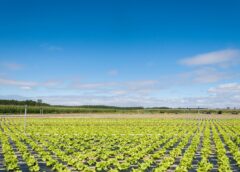Digital agriculture uses emerging technologies—including sensors, drones, and artificial intelligence—to collect crop data that can be used to enhance agricultural outcomes.
By Gabrielle Leal
Still relatively unknown to the general public, digital agriculture is becoming increasingly important in the global agriculture sector. This novel approach aims to improve farm and crop management by maximizing efficiency and increasing productivity through the use of cutting-edge technologies. Sensors, drones, artificial intelligence, and automation are among the technologies used to monitor soil conditions, climate, irrigation, and other variables critical to successful agricultural production.
RELATED: Genomics takes on crop disease
More data makes better farming
Digital agriculture technologies have the potential to significantly alter current agricultural practices. Digital agriculture is an interdisciplinary approach that includes knowledge from engineering, information technology, agronomy, and, of course, biotechnology. Although they may require a steep learning curve, digital agriculture’s tools can greatly aid in production when used properly.
Information and communication technology developments have enabled greater system integration and real-time data collection, allowing for more precise and efficient decision-making. Sensors, drones, and other tools allow farmers to continuously monitor soil, water, and weather conditions, as well as plant growth.
Producers can now obtain accurate and detailed information about growing conditions in real time, allowing them to make more informed decisions about when to plant, water, and fertilize their crops. By monitoring soil and water conditions, farmers can adjust the amount of nutrients and water provided to plants based on the plants’ specific needs; this practice helps to reduce waste, save money, and increase plant productivity.
Additionally, data collection helps farmers identify problems at an early stage, allowing them to take corrective action before challenges become larger. Another advantage of data collection is the capacity to foresee changes in weather and soil conditions in advance, which helps farmers take preventive actions to avoid losses and limit hazards connected with inclement weather.
RELATED: Scientists created cell-derived coffee in a lab as alternative to growing coffee plants
Digital agriculture and biotechnology have a lot in common and complement one another well. Producers may develop more adaptable crops with larger yields in less time by combining these two tools. Biotechnology enables the development of plants that are more resistant to climate change and disease, whereas digital agriculture enables farmers to monitor and manage their crops more precisely and efficiently.
Digital agriculture can be an incredible resource in the production of genetically modified organisms (GMOs), allowing farmers to monitor and control plants in real time. It is possible to evaluate plant performance, identify potential problems, and take corrective action more promptly. Furthermore, digital agriculture enables GMO monitoring, assisting farmers in meeting government laws and guaranteeing that their crops are safe and of high quality. Real-time data collection also helps to improve GMO production efficiency and productivity by allowing farmers to utilize fewer inputs and resources while increasing output.
To summarize, digital agriculture is an innovative strategy that provides enhanced agricultural productivity and efficiency. Sensors, drones, and other equipment capture data in real time, allowing farmers to make more precise decisions. When combined with biotechnology, digital agriculture encourages the development of crops that are more resilient, adaptive, efficient, and productive.
References
Clapp, J., & Ruder, S. L. (2020). Precision technologies for agriculture: Digital farming, gene-edited crops, and the politics of sustainability. Global Environmental Politics, 20(3), 49-69.
DÖRR, Jörg; NACHTMANN, Matthias. Handbook Digital Farming. 2022.
Husby, J. (2007). Definitions of GMO/LMO and modern biotechnology. Biosafety First: Holistic Approaches to Risk and Uncertainty in Genetic Engineering and Genetically Modified Organisms, 569-581.
Sarker, M. N. I., Islam, M. S., Murmu, H., & Rozario, E. (2020). Role of big data on digital farming. International Journal of Scientific & Technology Research, 9(4), 1222-1225.
Shang, L., Heckelei, T., Gerullis, M. K., Börner, J., & Rasch, S. (2021). Adoption and diffusion of digital farming technologies-integrating farm-level evidence and system interaction. Agricultural systems, 190, 103074.
Parekh, S. R. (Ed.). (2004). The GMO handbook: genetically modified animals, microbes, and plants in biotechnology. Springer Science & Business Media.
About the Author
Biotechnologist Gabrielle Leal has over ten years of lab experience and a master’s degree in the field. Microbiology, industrial bioprocesses, and intellectual property are among her areas of expertise. She is fascinated by the research and advancement of biotechnological approaches for various applications.

